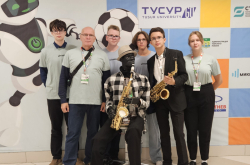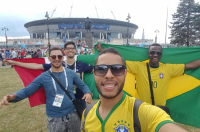The script was based on the 1920 play “R.U.R.” by the Czech writer Karel Čapek in which he introduced the word “robot” for the first time. While the play was written nearly 100 years ago, the issues it raises are just as relevant today. Even then, the author foresaw the possible ethical and social issues that could arise from the creation of artificial intelligence.
“The play was adapted according to the modern understanding of artificial intelligence. However, for the most part, the original text was preserved,” comments Alexandra Nikitina, tutor of the Foreign Languages Training Center and the production's scriptwriter.

We spoke to Valentina Diulger, who directed the play, about how the play came about, the challenges that were faced and her future plans.
Where did the idea for the play come from? Why did you choose this particular play?
The desire to stage this play came to me about 10 years ago after I first read it in English. But this year, magically, the long-standing desire, location, time and technical needs all came together.
I was really inspired by last year’s Shakespeare play. Knowing that this year there was no play being planned at the university, I consulted with my colleague Alexandra Nikitina and, with her support, proposed this idea.

The theme of the play could not be better suited for ITMO University, and Alexandra's and my idea was strongly supported Maria Didkovskaia, the head of the Internationalization Department.
How did the auditions go?
We didn’t have a huge competition for the roles, but we were surprisingly lucky that those people who came to the auditions were perfect for the parts, and were also multi-talented people who created and edited a video, made costumes, created props, and picked and mixed the music. We were also lucky with the others who helped, like the dancers, Alexander Popov who created the website, and Master's students from the Creative Lighting Design School of ITMO University, who did the play’s backdrop using projection mapping.

Did you encounter any challenges while working on the play?
Perhaps the most difficult thing was to gather everyone together at one time in one place for rehearsals. The number of people in the play was not small: 11 actors and 12 dancers, as well as technicians, lighting and sound engineers. And everyone’s got jobs and classes. We’ve even had to recast some of the characters.
Are there any plans to take on further productions of this kind, now that you have so much experience?
Everyone involved became really good friends. They developed important personal qualities - at the very least, a sense of responsibility. And we are determined to continue working together and offer our new ideas for productions. So a new performance is not far off.
Foreign Languages Training Center





